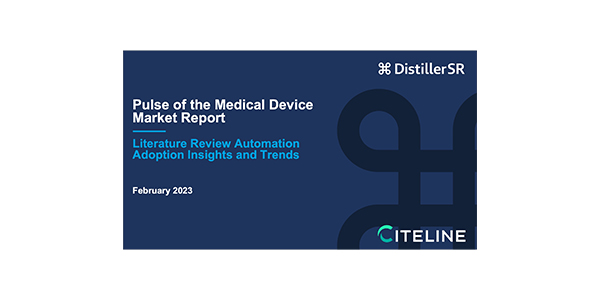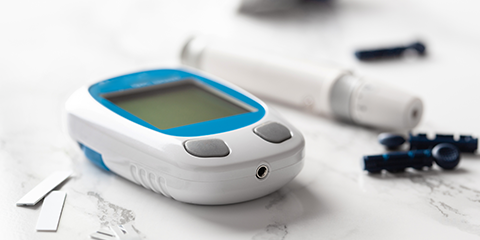Survey
Pulse of the Medical Devices MarketKey Takeaways
Literature reviews are an essential step for evidence collection and continuous surveillance throughout a medical device lifecycle. Concurrently, it is especially important to develop a sustainable, robust and systematic literature review strategy to comply with market entry and post-market requirements. To many manufacturers developing a literature review strategy also presents an opportunity to take a holistic view of the organization and identify areas to improve productivity while managing cost efficiently. Replacing manual literature review processes with the help of a software platform might be one of them.
We recently surveyed global professionals in the in-vitro diagnostics and medical devices industry to fully understand the level of organizational preparedness and management maturity in literature review practices in the industry.
Here are the key takeaways:
1. Literature Review Management Software Users Are Two Times More Confident in Their Regulatory Submissions
Sixty-six percent of the respondents who invested in a literature review software are more confident that their regulatory submissions will be approved versus thirty-eight percent of the respondents who are currently using spreadsheets and conducting literature reviews manually. Timely regulatory submissions remain an ongoing challenge for medical device manufacturers, even in light of the recent 2027 deadline extension. Rejected submissions can negatively impact time to market and result in unforeseen costs.
2. Seventy-three Percent of the Respondents Who Have Adopted a Literature Review Management Software Trust the Quality of Their Data.
Only thirty-eight percent of the respondents who are using spreadsheets to conduct their literature reviews trust the quality of their data versus almost three quarters of the respondents who use a literature review software platform. Manual literature reviews are time-consuming, error-prone and resource intensive. Errors can lead to omitted references, mistakes and regulatory submissions that are likely to raise red flags with notified bodies.
3. Literature Review Software Adoption is Enabling Data Traceability for Sixty Percent of the Respondents
Only four percent of the respondents who are using spreadsheets to manage their literature review data trust their ability to track data in real-time and the traceability of included and excluded references versus 60 percent of the respondents who use literature review software. Data traceability throughout literature reviews result in audit-ready, compliant regulatory submissions and efficient project management.
4. Manufacturers Are Using Literature Reviews Throughout the Medical Device Lifecycle
As previously mentioned, literature reviews have become a critical component of the medical devices lifecycle. Evidence collection starts in the basic design phase to determine how the device will fulfill unmet demand or improve current devices available in the market and carries through competitive analysis, cost-effectiveness studies to successfully demonstrate measurable benefit for reimbursement and continuous surveillance for adverse effects and safety signals. Traditionally, literature reviews are costly, laborious, and complex but the outcome is a source of truth that is reliable, trustworthy and the cornerstone of policies and regulations that ensure the safety of all medical devices.
5. Continuous Data Collection is Driving Efficient Evidence Management for Sixty-four percent of Literature Review Management Software Adopters
Systematic and proactive evidence monitoring is key to a successful post-market surveillance strategy and subsequent regulatory compliance. Continuous surveillance enables teams to detect safety signals and adverse events early. Sixty-four percent of the respondents who have adopted a literature review management software compared to thirty-five percent of spreadsheet users.
Our survey findings indicate that organizations who have adopted literature review software solutions are better equipped to meet industry standards and avoid potential setbacks in the regulatory review process. An interesting example comes from one of our recent webinars that explored the relationship between literature review software automation and confidence in regulatory submissions. DistillerSR customer Emily Metcalfe, Senior Manager, Clinical Product Risk at Boston Scientific, mentioned that transitioning from manual to automated literature reviews enabled her team to work collaboratively sharing a single source of truth for all clinical evidence, answer questions from notified bodies more efficiently and keep up with the latest evidence for frequent regulatory submissions.
Download the full Pulse of the Medical Devices Market Survey and get all the insights about the importance of investing in technology and automation to streamline literature review practices.

Download the full Pulse of the Medical Devices Market Survey
Get all the insights about the importance of investing in automation to streamline literature reviews.
Related Resources

Blog
How DistillerSR has empowered market leaders Philips and Alcon to achieve faster and more accurate literature reviews for CER submissions.
Philips
Philips achieves faster, more accurate literature reviews for CER submissions with DistillerSR.

Blog
Developing a repeatable, transparent process will lead to streamlined, audit-ready, and compliant literature reviews for your PER submissions.



